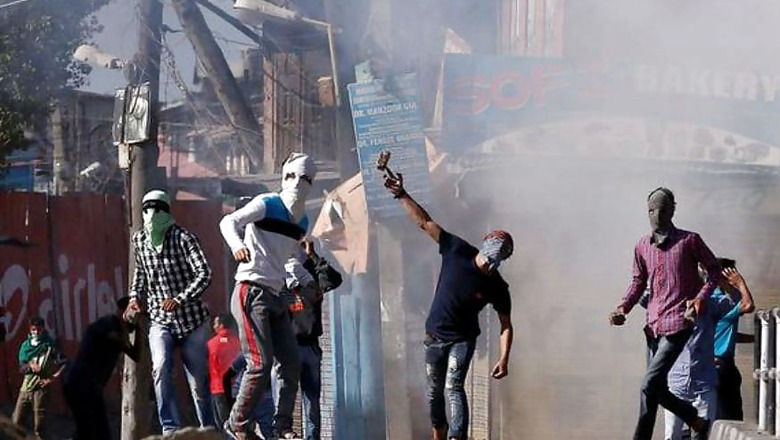
views
The death of 22 year-old R Thirumani, a tourist from Tamil Nadu, has exposed the stark reality of the direction in which Kashmir protests are headed. Violence and brutality is quickly overshadowing the 'political' character of resistance. Tourists were recently attacked at Pahalgam, civilians have been killed in places like Baramulla and Hajin on the mere suspicion of being informers, and an eight-year-old student landed in hospital with a head injury when a stone smashed through his school bus window.
The trends have been evident for some time. The targeting of Amarnath yatris in 2017, the murder of Lt Umar Fayaz, the lynching of DSP Ayub Pandith and the killing of policemen while on leave were clear portends. Today, gangs of goons, as Omar Abdullah rightly called them, roam the streets with rocks in their hand, targeting unarmed innocents. Stone pelting seems to have become an end in itself, with no thought of the impact this is having on the political, social or economic future of Kashmir.
Despite the changing nature of protests, those who claim to represent Kashmiri civil society seem unable to break their old shackles and mindset. Politics plays out on predictable party lines. The Hurriyat leadership finds solace in churning out protest calendars and eulogising terrorists who are killed.
Human rights activists blame violations of the past and the choking of political space for the current bout of violence. If there is anything new, it is the depressing sight of a mother being made to press the trigger of a gun during her son's funeral.
Instead of introspecting, one standard refrain is to paint the Indian Army in villainous colours. Today, the Army is the most professional and a completely secular force operating in Jammu and Kashmir. It is working under tremendous pressure and challenges, and at its forefront is its young leadership.
These are the Captains and Majors who lead the patrols that face daily hostility from stone wielding crowds. These officers have two crucial tasks. The first is to neutralise those who have picked up the gun against the state. It does not matter whether the terrorist holed up inside the house entered the war against the nation seven years or seven hours ago. Either he surrenders or is killed. That is the harsh reality.
The second task of the young officer is to protect the men he commands. If a murderous mob attacks his men, he will go to any extent to save them from harm. If he fails to do this he is a poor leader. In doing these tasks, he has the backing of the complete nation. These thoughts were recently reiterated by General Bipin Rawat in an interview with the Indian Express.
Therefore, constantly blaming the Army serves no useful purpose. The security forces do not go around seeking an excuse to attack civilians. It is just the other way around with stone pelters looking for opportunities to create mayhem and chaos. It is time for the Kashmiri civil society to look inwards and see where they are headed.
If innocent people continue to be targeted, the reasoning, that the youth have been forced to adopt this path due to government policies and apathy, will find few takers. There is no doubt that the government has to step up its efforts towards youth engagement but does the civil society have absolutely no role? Has it surrendered all its space to lumpen elements? These are some serious questions that must be answered. And the easy path - condemnations on social media – will not lead to finding a comprehensive solution.
When pellet guns were being fired at protesters and the defining image was of Insha Mushtaq, a young girl with her face pockmarked and both eyes damaged by hundreds of pellets, there was a wave of sympathy. This sympathy has quickly been diluted by pictures of crowds resorting to mindless violence to show their angst. And the argument that stones are less lethal than pellet guns, and therefore more acceptable, is completely absurd.
In a paper titled, The power of nonviolence: Confirming and explaining the success of nonviolent political movements, SN Orazani and Dr Bernhard Leidner have suggested, “that in the context of political struggles, the use of nonviolence increases support through enhancing a movement’s perceived morality and victim status.” They further go on to state that, “people not only sympathize with underdogs (here: nonviolent movements) and want them to win, but – perhaps more importantly –that they also see them as more capable of winning than violent movements.”
The Kashmir movement, with its almost total reliance on violence, is fast losing credibility and is no longer seen as being capable of winning. I am not attempting to dilute the responsibility of the government in creating a positive environment in Jammu and Kashmir but no solution can be found without the participation of the people. The youth have to be convinced that their current approach has little chance of succeeding.
The Kashmiri civil society can continue to harp on the past and lay the blame for all that is happening now on the mistakes that have occurred earlier. Or look at today for a defining #MeToo moment that enables it to take greater charge of its own future, one not held hostage to violence.
(The author is former Northern Commander, Indian Army, under whose leadership India carried out surgical strikes against Pakistan in 2016. Views are personal.)
















Comments
0 comment